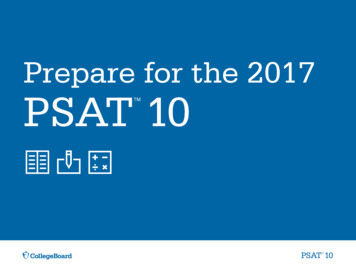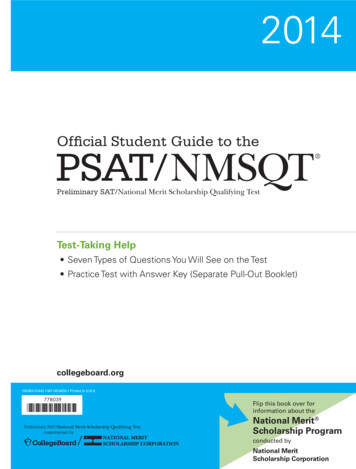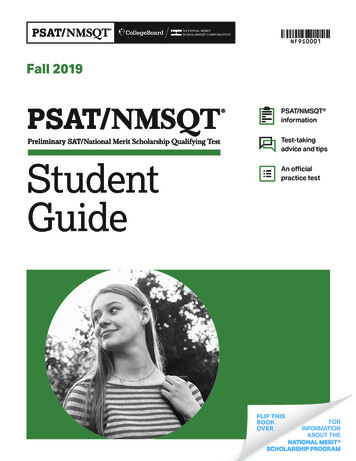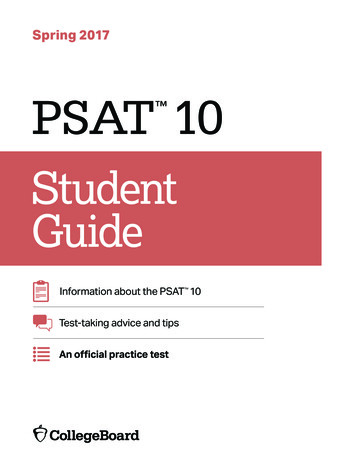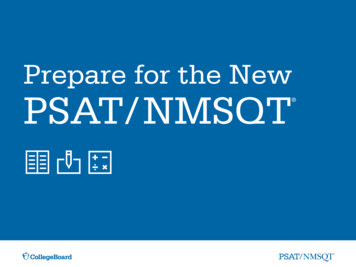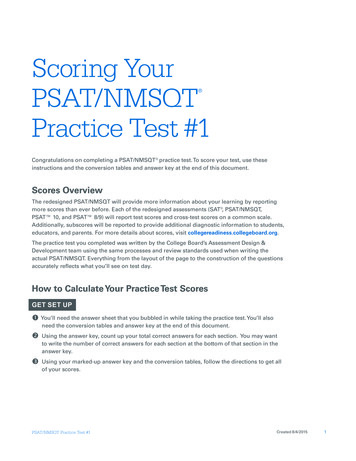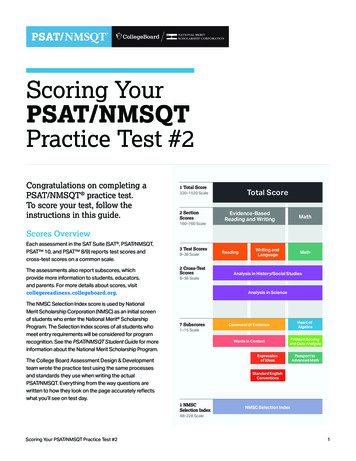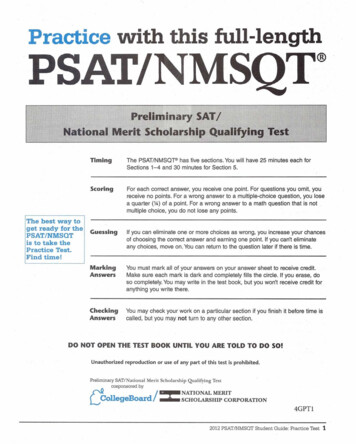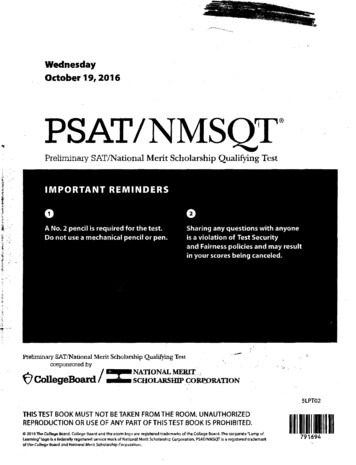
Transcription
, ;, :::- :- 1f"'s!",. , .« ' -·'--WednesdayOctober 19, 2016PSAT/NMSQT"Preliminary SAT/National Merit Scholarship Qualifying TestIMPORTANT REMINDERSA No. 2 pencil is required for the test.Do not use a mechanical pencil or pen.Sharing any questions with anyoneis a violation of Test Securityand Fairness policies and may resultin your scores being canceled.Pre1.iminary SAT/National Merit Scholarship Qualifying Testcosponsored byfJ CollegeBoard /--. . . . . NATIONAL ME.WT -. scuoLARSHIP coROORATION5LPT02THIS TEST BOOK MUST NOT BE TAKEN FROM THE ROOM. UNAUTHORIZEDREPRODUCTION OR USE OF ANY PART OF THIS TEST BOOK IS PROHIBITED.Cl 2016 The College Board. College Board and the acorn logo are registered trademarks of the Col\,ege Board. The corporate-lamp ofLearning logo is a federally registered service mark of National Merit Scholarship Corporation. PSAT/NMSQT ls a registered trademarkof the College Board and National Merit Scholarship Corporation.111111111111791694
12/16/2016about:blankReading: Question 1Questions 1 9 are based on the following passage.This passage is adapted from Isabel Allende, Portrait in Sepia. 2001 by HarperCollinsPublishers. The setting is Chile during the late nineteenth century.LineThere was a general consensus in the family that I was “goingto come to a bad end.” By then the first woman doctor hadgraduated in Chile, and others had entered the university. Thatgave Nívea the idea that I could do the same, if only to defy the5family and society in general, but it was obvious that I didn’t havethe least aptitude for studying. Then Severo del Valle appearedwith the camera and set it in my lap. It was a beautiful Kodak,precious in the details of every screw, elegant, smooth, perfect,made for the hands of an artist. I still use it, it never fails. No girl10my age had a toy like that. I picked it up with reverence and satlooking at it without any idea how to use it. “Let’s see if you canphotograph the dark shadows in your nightmares,” Severo delValle said as a joke, never suspecting that that would be myone objective for months, and that in the task of deciphering that15nightmare I would end up in love with the world. My grandmothertook me to the Plaza de Armas, to the studio of Don Juan Ribero,the best photographer in Santiago, a curt man as dry as stalebread on the outside, but generous and sentimental inside.“I’ve brought you my granddaughter to be your apprentice,”20my grandmother said, laying a check on the artist’s desk while Iclutched her skirttail with one hand and my brand new camera inthe other.Don Juan Ribero, who was a half head shorter than mygrandmother and half her weight, settled his eyeglasses on his25nose, carefully read the amount written on the check, and thenhanded it back to her, looking her up and down with reports?orgId 1153891/3
12/16/2016about:blank“The amount isn’t a problem. You set the price,” mygrandmother wavered.30“It isn’t a question of price, but of talent, señora,” he replied,guiding Paulina del Valle toward the door.During that exchange I’d had time to take a quick lookaround. Ribero’s work covered the walls: hundreds of portraits ofpeople of all ages. Ribero was the favorite of the upper class, the35photographer of the social pages, but the people gazing at mefrom the walls of his studio were not bigwig conservatives orbeautiful debutantes, but Indians, miners, fishermen,laundresses, poor children, old men, many women like the onesmy grandmother helped with her loans from the ladies club.40There I saw represented the multifaceted and tormented face ofChile. Those people in the photographs touched something deepinside me; I wanted to know the story of every one of them. I felta pressure in my chest, like a closed fist, and an uncontainabledesire to cry, but I swallowed my emotion and followed my45grandmother out with my head high. In the carriage she tried toconsole me: I shouldn’t worry, she said, we would get someoneelse to teach me to operate the camera, photographers were adime a dozen; what did that second rate lowborn think, anyway,talking in that arrogant tone to her. Paulina del Valle! And she50grumbled on and on, but I wasn’t listening: I had decided that noone but Juan Ribero would be my teacher. The next day I left thehouse before my grandmother was up. I told the coachman totake me to the studio and planted myself in the street, preparedto wait forever. Don Juan Ribero showed up about eleven, found55me at his door, and ordered me to go home. I was shy then—Istill am—and very proud; I wasn’t used to asking for anythingbecause from the time I was born I was coddled like a queen, butmy determination must have been very strong. I didn’t movefrom the door. A couple of hours later, the photographer gId 1153892/3
12/16/2016about:blank60out, threw me a furious glance, and started walking down thestreet. When he came back from his lunch, he found me stillthere with my camera clutched to my chest. “All right,” hemuttered, defeated, “but I warn you, little girl, that I won’t giveyou any special consideration. Here you come to obey without65talking back and to learn quickly, is that clear?” I nodded silentlybecause my voice was stuck in my throat.How did Paulina del Valle expect to persuade Don Juan Ribero to take on her granddaughteras an apprentice?A.B.C.D.By paying him generouslyBy flattering himBy appealing to his sympathyBy supporting his social ambitionsChoice A is the best answer. It is clear Paulina del Valle intends to use her wealth to persuadeDon Juan Ribero to mentor her granddaughter in photography. This can be seen in the secondparagraph, when she begins her interactions with him by “laying a check on the artist’s desk.”That idea is further supported in the fourth paragraph when, after Ribero returns the offeredcheck, Paulina del Valle then implies she will pay more by telling Ribero, “You set the price.”Choices B, C, and D are incorrect because the only interactions that occur between Paulina delValle and Don Juan Ribero are described in the second through fifth paragraphs and focus ondel Valle’s attempt to convince Ribero with her checkbook, but at no point does she flatter him(choice B), appeal to his sympathy (choice C), or offer to advance his social ambitions (choiceD).Question Difficulty: gId 1153893/3
\toJ,er. Paulina del Valle! And she grumbled on andon, but I wasn't listening: I had decided that no onebut Juan Ribero would be eachei;., The next day I.left tiielioiise before my grandmother was up. JJ.2.1.dt\li'.? J!O,,WJ,YS!U1lC.!9 f u 65 p nted my l,(inJhe.sti:eet, pi;epared.to.waitiorare.t.Don Juan Ribero showed up about eleven. fQllllQJileat his door, and .ordereq n1e to go home. I was shythen-I still am-andyery p;:oud; I wasn't used to .as1 i.i!g f2! any!hl!llll!ecauseJwrn the time I .was.b,mL.70 I wa;; coddled like a gueett, but my: iW"!'.lllffia.tion,must have been very strong. I didn't move from thedoor. A couple of hours later, the phot9grapher cameout, threw me a furious gla!lce, and started wal down the street. W'hen he came back from his lunch .75 he found me still there.with !.Il Ul.clutched t;;.mY- !l st "All right," he muttered, defeated, '.1,ut Iwarn }'.9!!,. !tle gi:!, t!t11tLwon't give you.any.specialconsi'½,ration. Here y m u : o m · king ba k ag JJo leam. quicldy,.is that.clear?'.'.lBO nodded silently because my voice was stuck in mythroat.60The passage describes an important distinctionbetweenPaulina de! Valle's behavior toward her relatives} and her behavior toward those who are poor.Paulina de! Valle's benevolence and Severo de!Valle's benevolence. [A)·@@ Don Juan Ribero's polite behavior and hisrebellious feelings.f' }JDon Juan Ribero's professional activities and hisI. ) preferred projects.-Which choice best supports the idea that Paulina de!Valle feels that she is entitled to special treatment?'A) Lines 24-25 ("I've . apprentice")'Lines J -60 ("we would . de! Valle")Lines 60-61 ("And she . listening")D) Lines 62-65 ("The next, . forever")How did Paulina de! Valle expect to persuadeDon Juan Ribero to take on her granddaughter as anapprentice? -By paying him generouslyBy flattering him ·. By appealing to his sympathy1D).By supporting his social ambitionsUnauthori?ed copying or reuse of any part of this page is illegal.3CONTINUE
11- . - ,- ,. .-,., . ,,.,-., 'I\, v-,.·.,::,,,,.,,. U .,, "" "-,1 .f!;'l"'I,,. .,. .,,. ,.····'-' , .''.\·:i-ci'·11.s used in line 33, "set" most nearly meansIn thefust paragraph, the narrator emphasizes theicontrast betweenposi.@'the benefits of a life of wealth and privilege andthe rewards of determination and hard work.0apply.). 1 determine.' earnest attitude and Severo de! Valle'sherplayful tone.@ the family's overwhelming preoccupation with,@-materialism and her focus on art and beauty.her attempts to assert her own independence andthe grandmother's authoritarian control over thefamily.As used in line 38, "exchange" most nearly means@ trade.-. difference.conversation.barter.Lines 28-37 ("Don . door") primarily serve to portray the grandmother's response to a reJechon.reveal Don Juan Ribero's personality through. his behavior.·(c) 'point out Don Juan Ribero's changeable nature. - emphasize the serious nature of a setback for· Don Juan Ribero.Unauthorized copying or reuse of any part of this page is illegal.4CONTINUE
·l.-··.1·· :-'-.'.Which choice provides the best evidence for theVlhich statement about Don Juan Ribero helpsexplain why he changes his mind about teachingthe girl?!U:. He is desperate to continue working.answer to the previous question?-':::) L1nes 19-23 ("My1. inside")Lines 41-48 ("Ribero . club")·fiJ He is not as unkind as he appears.Lines 72-74 (" A couple . street") Lines 78-79 ("Here . clear")He realizes he has much to lose otherwise.He recognizes the girl's talent. -edcopying or muse of any part of this page is illegal.5CONTINUE
more logic p aran1(lunt among them. For the firsttwo centuries of industrial history, the poweredtechnologies use to find and.extract fuels improvedfa s! rthe h.orj n, of supply receded. Hence ourblue-whale 1 energy economy. End users consume45 igg-eas .Yf !!'J' act and in jense form.s of .:Jl!'ld !"" rei}irig on supplie!s to pursue and incr distant, dj d, and dilutesources of raw:Juel. The.gap.is fQrever widening, as.tbs; history of oil extramon r btit that doesn'.tso stap,UJz-tl\l:.m.Qi:e,ene.gy.weronsmne, the more wec.apJ:l.lE, It's a chain reaction and it spiajs up, .9td . !t , if }'.Q.'-! wijl .,11.erp.et.u;JJ e.The m a ttine is running Dlster today tban rbefore, but it has been running.fi;,,:.51uite some tln?e,55 I'9ur billion years ago, life on Earth.c.aptur d solare11 rg}'.i!, ll, beS\l ll§e 1;1:iere.Jl'.fill.nQ lj . Life]gen-gotafoqtg9ld, and thP Olptnre and co11si1mption of en jn the bjQ§Q Q\;fJ')!i!S l e n !ising e,:i?JC sJn.ce. Thethicker life grew on the surface of the planet, the60 more ene .gy the '1!0.spher,:m a.o ed.to c.apfU:re. Andit used all t llt energyJ9, r t -mi;, r Jife.· Li ng gceen.p!@X still Ptl!retosl lily's solar e !ler gy a bo ut sil'.lim lli!S r thai;i we hu mfl llLl\.1!.ab l t.,u;!Jg. up.y,e y-'s-;;ol,,r-eriergypreservedin65 'fossilfuels, but wi:.11 ove rt i!,keJj,e rest of nature indue.course. P1;rha1w someday we'll gettll. the 11ointwhere we, too, ca119!'.\.l!l'.e.9JKeJJe c:gy du:ectly:fr.omtl ie uj, Th e s plenty of sunlight t.:' spare-greenplants currenth::gw1Un: onfy .about 011.e.10 three-thousandth of the golden cas.;;;a k.of solar·power thaJ reaches th,:- Eartlt s sur.face. .· But whether we catch our solar ,:n.ergy.Jive, dig itu.P in fossikz d(orm, or miqe w:ani!lm instead isrealfy}ust a detail. The ont certainty is thatwe will75 extract more energy from our environme.nt,.not less.Everyihing we think l nO):l!J;l; out "runnin.g Oll! ofenergy isn't just muddled and wi: ong;it:s.the exactopposite of the truth.The more e ner gy we capture.and put to use, the more readily we will captureBO still more. -Questions 10-18 are based on the followingpassage and supplementary material.40.wanThis passage is adapted from Peter W. Huber andMark P. Mills, The Bottomless Well. 2005 by Peter W. Huberand Mark P. Mills.Though he was prepared to go quill: a bit deeperwhen he turned on his steam-powere4drill inCrawford County, P vania, in 1859,une Colonel Edwin Drake sti;w: et. The first5 "deep water" oil wells stood in l.O J;l'll.ter in1954. Today, they r fh through 10.00Jl.fe.e.Lof:ll'ater,2Q.,000 feet of vertkal mck, and another 30,{)00 feet fho;:;;;ontal rock.·-yet ov r-the long term, the prke ofoil has.held10 remarkably steady. T n-mile oil costs 1::ss tha n.69.feet.oiLdid, and about the s me § Q ru,,mjle pi)4id t v Q decades ago. P.roduction costs iIJ the hostilewaters of the Statfj.oriL9.-ilJield.Qfthe North.S i\l'.\'.not very. differ:ent from costs at.theJristoric15 Spin (jletop fields of soq:theast Texas a cenJ,l,lry ago.There have been price sp ils es3nd.sags, but they have !ie l to political and r egulatQJ)'inst,,.bilities, notdis.cov,;ry and extraction.costs. This record is all themore remarkable when one considers that the20 amount of oil extracted has risen year after year.Cumulative proch.iction from U.S. wells aloii.e hassurpassed a hundred billion barrels. The historicaltrenas clefv all intuition.It is l lgh to tl:tan.k 1)11J11 J:1.i11genuity for2s the relatively .steadJL.p.rice oLa finitt.an d (j,l'i11dlmgresource and leave it at.that. But there is a secondpart to this story: it is energy its e!f th i begets moreene gy. Electrically powered robots pursue newsupplies of oil at tbe bottom of the o cean, Ele,:tricity30 p and , lepes the silicon d:iat becomes thephotovoltaic cell that genrrates more electricity.La;;ers enrich uranium that generates more electri itythat powers more lasers. Power pursues the energythat produces the power.35- "Energy supply" is de.tennined not by "what's outthere" but by how good we are at finding and xtracting it. What is scarce is not raw energy but thedrive arid the logic that is able to locate, purify, andchannel it to our own ends-the creation of still copying o, reuse of any part ofth1s page is illegaLi A reference to the suggestion that a modern American usesabout as much energy as a blue whale does6CONTINUE
11Maximum Distance to Oilversus Average Price-40 ".' -·s-;"'-20.§10uoil price- , / ' 0. "b f', ,,,,,/ /Cj §,) ,ci'11,,, ,ci,,, :).Year IIIIIIIIIIII. t"'"'§II"';;:J-"'distance to oil-i ·30."2il desire of end users to conserve power wherever-aI 0N,."d;g"'In the pas.sage, the authors claim that the amount ofenergy available for human use is chiefly dependenton the "'gIFr'ffilo:lofsupply.Qi!.§s-e""Ji,/ 10··{l;)· ability to discover and draw from more sources . ::5;.,Ipossible.success of new uranium enrichmenttechnologies.future collection of solar energy directly fromthesun. ,!;,",,,5. 0""0" '----/:I.Which choice provides the best evidence for theanswer to the previous question?1,#'Lines 32-33 ("Lasers . more lasers")· Lines 3.5-37 ("Energy . it")Lines 55-56 ("Four . no life")Adapted from WTRG Economics; EIA, Annual Energy Review, 2003by ExxonMobil; J. Ray McDermott Inc.Lines -68 ("Perhaps . sun").According to the passage, the relationship betweenenergy extraction and use by humans is bestcharacterized aslaJ ed by excessive demand.self-propagating and propulsive.driven by political dissension.existing in competition with natural processes.Unauthor"IZ ropyjng or reuse of any part of this page is llfegiil,7CONTINUE
tiIt-The details in lines 28-33 ("Electrically . . lasers")rve mainly toWhich choice provides the best evidence for the.{nswer to the previous question?support a claim. -tines 24-26 ("It is . that")"5fJ ,: Lines 37-39 ("What . ends") tf'.nes 51-52'(:It:s a . machi e")/' )- )'.,mes 62-65 ( L1vmg . fuels ) .Im -As used in line 17, "tied to" most nearly means,{». seek.', ) united with.11)As used in line 46, "pursue" most nearly means :connected to. boundby.chase.i engage in.@equivalent to.);J:,, proceed with.,.8CONTINUE
11'iIn the passage, the "gap" (line 48) refers to thedisparity between the increasingdistance of energy sources from Earth's surfaceand the decreasing quality of high-grade powerobtainable from them.· concern over the environmental risks of,Ji extraction and the decreasing attention to the. . actual impact of current extraction methods.awareness of the history of extraction and the,. decreasing concern about likely future . developments. concentration of energy as it is used and thedecreasing concentration of supplies ofunextracted energy.According to the graph, the maximum distance to oilfirst reached 25,000 feet during which span of years?i.1875-19001925-19501950-1975,1975-2000i Unauthorized copying or reuse of any part of this pag.e Is illegal.9CONTINUE
11Questions 19-28 are based on the followingpassage and supplementary material.This passage is adapted from Lee Alan Dugatkin, Principlesof Animal Behavior. 2009 by W.W. Norton & Company, Inc.In systems in which predators hone in o ngsI]!ade by therr prey, one ·of the simplest things nanimal can do to avoid such predators is to be gUie.t.Une With this in mind, L Rt roage-Healey and bis ,5 colleagues examined theJO]e of sounc!J;messionin the antipredator repertoire of the G11lftaadfishGulf toadfish are a major food staple.ofad:dtbottlenose dqjp.htns, making up 13 perce t of thedolphin's diet. Prior work had shown that dolphins10 orient toward the "hnatwhistle" annd pt elH!eefl bymale toadfish during breeding season. That.is,,3o!phms are raYesclmpping,m 1ru,.,.js producedbx toadfish toJ2ett r ocient.to,11,mi tbeii: p y. Once atoa.Qfi sh is locajs,d by: e.av.esd.mpping,.tbg gg lP-,hip.15 locks onto this prey and tracks it. (}iven this,the questio .R.-. :.m.age,Healey anc! his.colleagues .addressed was whether the toad/ishrespond in kind,listening'foi sounds associated.wi1:h bottlenosefon,gmpehavior, d fum.reducing the boatwhistle20 sn mds hey produce.·Bgtt)eoose dolphlns 12roduce a variety af diffei:.entsounds, rapging from mgh.frequency whis. !:'sedin fiolphin-to-dolphin soc; ial .:omrouw' .aJ;ion (notforaging), as well as tw SQl1!19S thatare p ,!.r):icular.\y25 associated with foraging-" clicks" and l o c y"p ip.&" The pops are easiest for toadfish to he ar,since this species hears most accurate!y i!i thelow:,.freguency range, and so Remage-Healey and !usteam focused on these dolphin solll)iJs.10The researchers c.tll!!!.red tnadfish during thebreedin g season, and they keJ1! individual males intanks until the breeding season ended. The malessoon b egan !Q emi.lb.9. tle sounds, presumablytoattr ct females. At that point, naclfisb roa),:i; were35 expcised: \§"oiJ.e.of.three-sounds-thP pops associatedwitlidoiphin foraging, the bigh-hquenq:whistlesP (!duc e d during dol phin social commnoication,and, as a control, the " mapping" sounds made bysnapping shrimp. All sounds were broadcast using40 underwater speakers, and the activity oftoadfish wasrecotdedfor.the.five-minutes be(o.i:e sounds were.;;:;;-tted, the five mim1t eI ciurjng which the .experlmeni:al s.ounds we,re.ru:oadcast,.and--thefive min11tes after the sounds wereplayed. ---adcopying or reuse of any part of this page is illegal.Remage-Healey found clear evidence o(antipredator responses when the tqadfisb br'ln\ popsourids. No differences were found in call ratebetween males before exposure to the experimentalsounds, /See graph.) Males e osed to popyQun ds,50 however, reduced \h. i! J:lll.G:ates.hy.50-perce.ot. Inaddition, males exposed tq the pap sounds.maintained their reduced caUiog.ute.for.tb.e.:.Jfri: roioutes.fo.llawing expasure.to.p.ops-that is,reduced .they vesdr Qpped,on their predators55 th )ivity in a way: thatmade capture by-a d0lphin1.ess.Jike4i. Males in lb other treatments showed nochanges in boatwhistle call rate when they heard theq:.carded-solillds.RemageaHeaky @d his team followed up their60 behavioral work Q!L9)! rates ana exposurepred4\Q!L'fith a hormonal.ru!alY§is that examinedwhether dolphin pops produce a stress response inthetoadfish. After P',;perirornraUJ[ Q§ing the maletoadfish to .J1QP.§ or S!! apping shrimp sounds, the. ,65 researchers 4!:ew .tlie.males, andtheymeasured their cortiso1 1 levels. Maks exposed topoQs not only responded to the '2 S by reducingtheir ownboatwhistle call, but.they also showedhigli Jev;ls-of cortisol than maj § e,cpQ§ed to tl).e10 sound o f snappJ. c.4510an ro -1 A hormone produce"d in response to stressGulfToadfish Responses to Various Sounds160 ------------ 140- ----------------"' 1 2 0 - - - - - - - - - - - - - - I.05 100 80604082 rplaybackperiod dolphin whistles and popsD dolphin pops alone dolphin whistles alone!!ill snapping shrimp popsCONTINUE.,.I
1111The passage indicates that the researchers chosedolphin pops to broadcast primarily becauseThe author mentions that toadfish are "13 percent ofthe dolphin's diet" (lines 8-9) most likely torJ!I:'lfkAeliminate an irrelevant factor from\Y. - consideration. f dolphin pops would be audible over the toadfish ·suggest that an ambitious project is unlikely· boatwhistles.to succeed.' ) explain a problem by way of analogy. dolphin pops bear a close resemblance to soundsmade by snapping shrimp.- clarify the reasoning behind a choice. -- toadfish call rates would remain elativelyconsistent in response to dolphin pops. "As used in line I 5, "tracks" most nearly means-.X marks.@)Q.other dolphin foraging sounds are more difficultfor male toad fish to hear.follows.Which choice provides the best evidence for the e r to the previous question?observes. Lines 26-28 ("The pops . range")) X" carries.iLines 34-35 ("toadfish . three sounds")Lines 51-53 ("males exposed . pops")Lines 56-58 ("Males in . recorded sounds"))Unauthorized copying or reuse of any part of this page is illegal.11CONTINUE
tiBlBlThe main purpose of the fifth paragraph(liIIes 45-58) is toiThe passage most strongly suggests that exposure todolphin pops causes male toadfish to. ·. - !\.) - reduce their foraging behavior.) summarize findings.')B) emit only high-frequency sounds.evaluate a claim.i ;,,,:::'Q· shift their direction away from the pop sounds.revise an initial hypothesis.NJ); undergo a hormonal stress response.\:.7. - explain unanticipated consequences.s used in line 62, "produce" most nearly meansWhich choice provides the best evidence for the.answa-to the previous d copying or reuse of any part of this page is illegal.t12Lines 45-47 ("Remage-Healey . . sounds")Lines 49-50 ("Males . percent")Lines 59-63 ("Remage-Healey . toadfish")Lines 66-70 ("Males exposed . shrimp")CONTINUE
11-·11) ."'--.,,,,,According to the graph, which of the following hadtl:) greatest effect on the call rates ofGulftoadfish?- The length of the playback periodSnapping shrimp pop sounds Dolphm pop sounds alone - Dolphin whistle sounds aioneIn the graph, the four bars showing the lowestcall rates primarily support Remage-Healey'sconclusion that;. ottlenose dolphins mimic boatwhistle sounds/.-'} to improve foraging.male toadfish inhibit their boatwhistle soundsfor self-protection. dolphin foraging behavior has a direct effect on/ \ toadfish reproduction. male toadfish vocalize less after playback than' - they do during playback.J.- I.· ·Unauthorized copying or reuse of any part of this page is illegal.13CONTINUE
12/16/2016about:blankReading: Question 37Questions 29 38 are based on the following passage.This passage is adapted from Gifford Pinchot, The Fight for Conservation. Originally publishedin 1910. Pinchot was a US politician and forest conservationist.LineNo man may rightly fail to take a great pride in what has beenaccomplished by means of the destruction of our naturalresources so far as it has gone. It is a paradoxical statement,perhaps, but nevertheless true, because out of this attack on5what nature has given we have won a kind of prosperity and akind of civilization and a kind of man that are new in the world.For example, nothing like the rapidity of the destruction ofAmerican forests has ever been known in forest history, andnothing like the efficiency and vigor and inventiveness of the10American lumberman has ever been developed by any attack onany forests elsewhere. Probably the most effective tool that thehuman mind and hand have ever made is the American axe. Sothe American business man has grasped his opportunities andused them and developed them and invented about them,15thought them into lines of success, and thus has developed intoa new business man, with a vigor and effectiveness and acutting edge that has never been equaled anywhere else. Wehave gained out of the vast destruction of our natural resourcesa degree of vigor and power and efficiency of which every man20of us ought to be proud.Now that is done. We have accomplished these big things.What is the next step? Shall we go on in the same lines to thecertain destruction of the prosperity which we have created, orshall we take the obvious lesson of all human history, turn our25backs on the uncivilized point of view, and adopt toward ournatural resources the average prudence and average foresightand average care that we long ago adopted as a rule of our rgId 1153891/3
12/16/2016about:blanklife?The conservation movement is calling the attention of the30American people to the fact that they are trustees. The factseems to me so plain as to require only a statement of it, to carryconviction. Can we reasonably fail to recognize the obligationwhich rests upon us in this matter? And, if we do fail to recognizeit, can we reasonably expect even a fairly good reputation at the35hands of our descendants?Business prudence and business common sense indicate asstrongly as anything can the absolute necessity of a change inpoint of view on the part of the people of the United Statesregarding their natural resources. The way we have been40handling them is not good business. Purely on the side of dollarsand cents, it is not good business to kill the goose that lays thegolden egg, to burn up half our forests, to waste our coal, and toremove from under the feet of those who are coming after us theopportunity for equal happiness with ourselves. The thing we45ought to leave to them is not merely an opportunity for equalhappiness and equal prosperity, but for a vastly increased fundof both.Conservation is not merely a question of business, but aquestion of a vastly higher duty. In dealing with our natural50resources we have come to a place at last where everyconsideration of patriotism, every consideration of love ofcountry, of gratitude for things that the land and the institutions ofthis Nation have given us, call upon us for a return. If we oweanything to the United States, if this country has been good to55us, if it has given us our prosperity, our education, and ourchance of happiness, then there is a duty resting upon us. Thatduty is to see, so far as in us lies, that those who are comingafter us shall have the same opportunity for happiness we havehad ourselves. Apart from any business consideration, rgId 1153892/3
12/16/2016about:blank60from the question of the immediate dollar, this problem of thefuture wealth and happiness and prosperity of the people of theUnited States has a right to our attention.Based on the passage, the author would most likely agree with which of the followingstatements?A.Government policies can be more effectively framed and implemented if publicopinion is consulted only sparingly.B.Future generations have a right to enjoy the same advantages that previousgenerations have enjoyed.C.Political leaders should prioritize citizens’ happiness over the enduring health of theeconomy.D.Voluntary actions on the part of businesses achieve conservation more effectivelythan government regulation does.Choice B is the best answer. In the last paragraph of the passage, the author shifts fromadvocating conservation as an economic necessity to arguing for it as a moral responsibility.This emphasis is especially clear in the last two sentences, where the author argues that sucha responsibility arises from future generations’ right to enjoy the same opportunities forprosperity as the present generation has enjoyed: “That duty is to see, so far as in us lies, thatthose who are coming after us shall have the same opportunity for happiness we have hadourselves. Apart from any business consideration, apart from the question of the immediatedollar, this problem of the future wealth and happiness and prosperity of the people of theUnited States has a right to our attention.”Choice A is incorrect because the passage does not concern itself with whether public opinionshould be consulted when setting government policies. Choice C is incorrect because ratherthan prioritizing happiness over economic health, the passage argues that economic health isvital to continued happiness. Choice D is incorrect because the passage does not consider thequestion of whether government regulation or business self regulation would conserveresources more effectively.Question Difficulty: orgId 1153893/3
1;111The author characterizes environmental"' rvation primarily as a esponsible form of civic engagement.Tqe author's central claim in the passage is thatffJj) future generations' success matters more than,the continued prosperity of today's generation.'1.,J businesses are lear
Oct 19, 2016 · October 19, 2016 , ;, :::- _:- ,. 1f"'s!" , . « ' -·' --PSAT/NMSQT" Preliminary SAT/National Merit Scholarship Qualifying Test IMPORTANT REMINDERS A No. 2 pencil is required for the test. Do not use a mechanical pencil or pen. Sharing any questions with anyone is a violation
